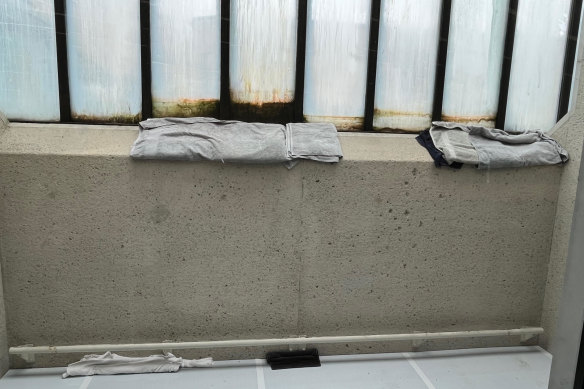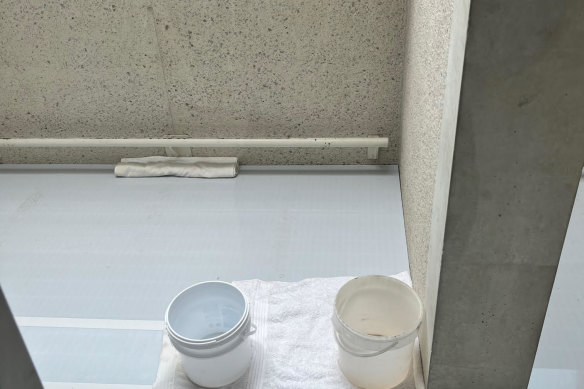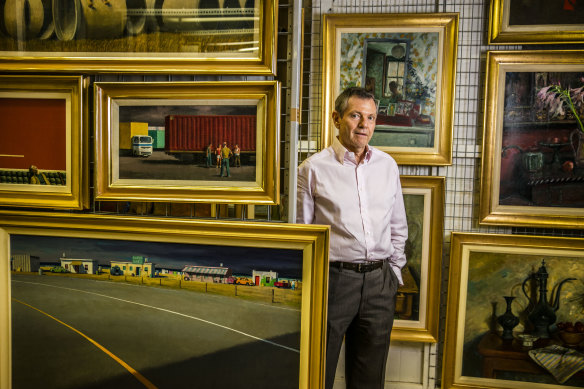This was published 2 years ago
‘A national disgrace’: Gallery uses buckets as building falls into disrepair
By Linda Morris
One of Australia’s most prominent arts industry figures has decried the state of the National Gallery of Australia in Canberra as a “national disgrace” as pictures emerged showing buckets and towels being used to mop up water leaking from the roof.
Brisbane art gallerist Philip Bacon, a member of the gallery’s fundraising foundation, said such leaks would be scandalous in other world-leading institutions.

National Gallery staff have been forced to use towels to prevent water damage in the building.
Images shared on private social media chat groups and obtained by this masthead show buckets and towels on a concrete ledge and the floor of the building’s uppermost level, where boardroom meetings are held and administrative staff are located. Artworks have had to be pulled from the wall of the boardroom as a result, and mould has penetrated three floors of the building.
Bacon said such leaks would be scandalous in galleries such as the Louvre or London’s National Gallery. Buckets and towels had been permanently on hand since 1997 when Bacon had become involved in the gallery.
“It’s a national disgrace, and I don’t use that term lightly,” he said. “The National Gallery is the repository of some the nation’s greatest works and here we are having to seriously ask ourselves: is this proper to place them in a building that is not secure to the elements?”
The images have come to light as the National Gallery, home to a $6.9 billion collection including American abstract masterpiece Blue poles, says it needs $265 million over 10 years to bring its building up to standard and make it waterproof.

Buckets are being used to collect water leaking from the roof of the National Gallery in Canberra.
In July, one-off government grants totalling $24.77 million for essential works expire along with $3 million in extra money for programs and exhibitions. The grants were awarded by the former Coalition government. Gallery chairman Ryan Stokes has warned of job losses, closing the gallery two days a week and the reintroduction of entry fees.
Finance Minister Katy Gallagher told parliament this week that the federal government would assist cultural institutions facing a looming budget crisis, which was left for the incoming government to deal with, but has not specifically addressed how much it would spend covering the National Gallery’s maintenance bill.
The gallery has blamed its water-leak problem on storm damage and an insufficient building maintenance budget. The problem is one of a litany of building failures the gallery is confronting, including lifts, revolving doors and air-conditioning that are approaching, or at, the extreme end of their working life.
Strategies are in place to manage the risk of damage to works of art, including the removal of art from high-risk water-leak areas and the display of sensitive works in watertight cases.

Philip Bacon at his gallery in Brisbane with works from the estates of Margaret Olley, Fred Williams and Jeffrey Smart. Credit: Glenn Hunt
Leading art conservator Julian Bickersteth, president of the International Institute of Conservation of Artistic and Historic Works, said water leaks inside a gallery posed a potential danger to any art collection.
Elevated and highly variable levels of humidity caused flaking as paint and canvas expanded and contracted at different rates. Old Dutch master panel paintings, of which the National Gallery owned a few, were particularly susceptible to relatively high levels of humidity, Bickersteth said. As the paint separated from the boards, they tended to warp. As a result, mitigation was “tricky” in voluminously spaced galleries.
“In the British Museum’s Elgin Marbles Gallery, there are buckets all over the place, and it really doesn’t matter how much humidity varies there because the Elgin Marbles are inorganic. But in an art gallery, it’s vital that relative humidity be controlled,” he said.
High-value works are stored on-site in various areas including the basement while the rest of the collection is stored at a second location.
‘The National Gallery is the repository of some the nation’s greatest works and here we are having to seriously ask ourselves: is this proper to place them in a building that is not secure to the elements?’
Brisbane art gallerist Philip Bacon
Bacon said there was no chance staff at the National Gallery would allow water to affect artworks. They had many years of experience watching out for leaks but mitigation measures should not have to be taken.
Leaks have so far mainly been confined to the upper floor, but water is said to have penetrated three other levels as well, causing mould. There is also evidence of rusting through the concrete walls.
More than $100 million is required for repairs to create a watertight building, but only $10 million has been allocated, of which $3 million has been spent on rectification works. Planning is under way for priority repairs related to glazing and roofing failures, and condensation and mould issues.
The gallery says it has a regular testing and cleaning regime to manage problems with mould. These issues are monitored, and recent air quality tests show mould levels remain within acceptable parameters to prevent harm to staff, visitors and the collection.
About 118 staff are located on the third floor of the gallery, where mould issues have been identified.
Arts Minister Tony Burke said building leaks were the legacy of the former Coalition government, which had deliberately run down the National Gallery and other cultural institutions.
Former arts minister Paul Fletcher said: “The Albanese Government has had ten months to address pressing issues facing our national collecting institutions including the National Gallery yet have failed to act. Why won’t Arts Minister Tony Burke act?”
A cultural guide to going out and loving your city. Sign up to our Culture Fix newsletter here.